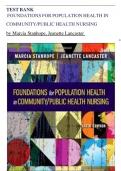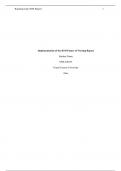TEST BANK
FOUNDATIONS FOR POPULATION HEALTH IN
COMMUNITY/PUBLIC HEALTH NURSING
by Marcia Stanhope, Jeanette Lancaster
6T
, Table of Contents
Chapter 01: Public Health Nursing and Population Health
Chapter 02: The History of Public Health and Public and Community Health Nursing Stanhope:
Chapter 03: US and Global Health Care
Chapter 04: Government, the Law, and Policy Activism
Chapter 05: Economics of US Health Care Delivery
Chapter 06: Ethics in Public and Community Health Nursing Practice
Chapter 07: Culture of Populations in Communities
Chapter 08: Environmental Health
Chapter 09: Evidence-Based Practice
Chapter 10: Epidemiological Applications
Chapter 11: Infectious Disease Prevention and Control
Chapter 12: Communicable and Infection Disease Risks
Chapter 13: Community Assessment and Evaluation
Chapter 14: Health Education in the Community
Chapter 15: Case Management
Chapter 16: Disaster Management
Chapter 17: Public Health Surveillance and Outbreak Investigation
Chapter 18: Program Management
Chapter 19: Healthcare Improvement in the Community
Chapter 20: Family Development, Family Nursing Assessment, and Genomics
Chapter 21: Family Health Risks
Chapter 22: Health Risks Across the Life Span
Chapter 23: Health Equity and Care of Vulnerable Populations
Chapter 24: Rural Health and Migrant Health
Chapter 25: Poverty, Homelessness, Teen Pregnancy, and Mental Illness
Chapter 26: Alcohol, Tobacco, and Other Drug Problems in the Community
Chapter 27: Violence and Human Abuse
Chapter 28: Nursing Practice at the Local, State, and National Levels in Public Health
Chapter 29: The Faith Community Nurse
Chapter 30: The Nurse in Public Health, Home Health, Palliative Care, and Hospice
Chapter 31: The Nurse in the Schools
Chapter 32: The Nurse in Occupational Health
, Chapter 01: Public Health Nursing and Population Health
Stanhope: Foundations for Population Health in Community/Public Health Nursin
MULTIPLE CHOICE
1. WHICH statement best describes community-based nursing?
a. A practice in WHICH care is provided for individuals and families.
b. Providing care with a focus on the group’s needs.
c. Giving care with a focus on the aggregate’s needs.
d. A value system in WHICH all clients receive optimal care.
ANS A
By definition, community-based nursing is a setting-specific practice in WHICH care is provided for “s
where they live, work, and attend school. The emphasis is on acute and chronic care and the provision
coordinated, and continuous care. These Nurses may be generalists or specialists in maternal–infant, pe
mental health nursing. Community-based nursing emphasizes acute and chronic care to individuals and
focusing on groups, aggregates, or systems.
2. WHICH statement best describes the goal of community-oriented nursing?
a. Providing care to individuals and families
b. Providing care to manage acute or chronic conditions
c. Giving direct care to ill individuals within their family setting
d. To preserve, protect, promote, or maintain health and prevent disease
ANS D
By definition, community-oriented nursing has the goal of preserving, protecting, or maintaining health
promote the quality of life. All Nurses may focus on individuals and families, give direct care to ill per
setting, and help manage acute or chronic conditions. These definitions are not specific to community-
3. WHICH of the fOllOwing is the primary focus of public health nursing?
a. Families and groups
b. Illness-oriented care
c. Individuals within the family unit
d. Health care of communities and populations
ANS D
In public health nursing, the primary focus is on the health care of communities and populations rather
and families. The goal is to prevent disease and preserve, promote, restore, and protect health for the co
within it. Community-based Nurses deal primarily with illness-oriented care of individuals and familie
aim is to manage acute and chronic health conditions in the community, and the focus of practice is on
family-centered illness care.
4. WHICH of the fOllOwing is responsible for the dramatic increase in life expectancy during the 20th ce
a. Technology increases in the field of medical laboratory research
b. Advances in surgical techniques and procedures
c. Sanitation and other population-based prevention programs
d. Use of antibiotics to fight infections
ANS C
There has to be indisputable evidence collected over time that public health policies and programs wer
increasing the average life span from 47 in 1900 to 78.6 years in 2017, an increase of approximately 60
through improvements in (1) sanitation, (2) clean water supplies, (3) making workplaces safer, (4) imp
(5) immunizing children, and (6) improving nutrition, hygiene, and housing. Although people are excit
discovered that cures a disease or when a new way to transplant organs is perfected, it is important to k
gains in the health of populations that have come largely from public health accomplishments.
5. A Nurse is developing a plan to decrease the number of premature deaths in the community. WHICH of
interventions would most likely be implemented by the Nurse?
a. Provide free health care to all citizens
, 6. What is the basic assumption stated by Healthy People 2010 as it relates to public health efforts?
a. Health disparities among any groups are morally and legally wrong.
b. Health care is the most important priority in government planning and funding.
c. The health of individuals cannot be separated from the health of the community.
d. The government is responsible for lengthening the life span of Americans.
ANS C
The major premise of Healthy People 2010 was that the health of the individual cannot be entirely sepa
larger community. Public health practice focuses on the community as a whole, and the effect of the co
(resources) on the health of individuals, families, and groups. The goal is to prevent disease and disabil
the health of the community as a whole. Public health can be described as what society collectively doe
exist in WHICH people can be healthy. The basic assumptions of public health do not judge the morali
focus is on prevention of illness not on spending more on illness care. Additionally, individual respons
choices is the directive for lengthening life span not the role of the government.
7. WHICH of the fOllOwing actions would most likely be performed by a public health Nurse?
a. Asking community leaders what interventions should be chosen
b. Assessing the community and deciding on appropriate interventions
c. Using data from the main health care institutions in the community to determine
needed health services
d. Working with community groups to create policies to improve the environment
ANS D
Although the public health Nurse might engage in any of the tasks listed, he or she works primarily with
community to carry out core public health functions, including assessment of the population as a whole
health and improving the environment. The interventions of asking community leaders WHICH interve
assessing the community and deciding on appropriate interventions, and using data from health care in
the engagement of the community when making decisions about what the community actually wants an
8. WHICH public health Nurse most clearly fulfills the responsibilities of this role?
a. The Nurse who met with several groups to discuss community recreation issues
b. The Nurse who spent the day attending meetings of various health agencies
c. The Nurse who talked to several people about their particular health concerns
d. The Nurse who watched the city council meeting on local cable television
ANS B
Any of these descriptions might represent a Nurse communicating, cooperating, or collaborating with c
groups about health concerns. A major challenge for the future is the need for public health nursing spe
aggressive in working collaboratively with various groups in the community as well as professional co
settings to deal with barriers to health. However, the Nurse who spent the day attending meetings of va
most representative, because in public health, concerns are addressed from a broader perspective. In pu
of the community should be addressed. Concerns are broader than recreation, individual concerns are n
priorities, and watching television (a one-way form of communication) is less effective than interacting
9. WHICH of the fOllOwing best defines aggregate?
a. A large group of persons
b. A collection of individuals and families
c. A collection of people who share one or more characteristics
d. Another name for demographic group
ANS C
An aggregate is defined a collection of people who share one or more personal or environmental charac
community can be defined in terms of either geography (e.g., a county, a group of counties, or a state)
children attending a particular school). These members make up a population. The term population may
with the term aggregate. A large group of persons, a collection of individuals and families, and anothe
group are not accurate definitions of the term aggregate.
10. WHICH question asked by a novice Nurse would be the most reflective of an understanding of the role
a. “WHICH groups are at the greatest risk for problems?”
b. “WHICH patients should I see first as I begin my day?”






